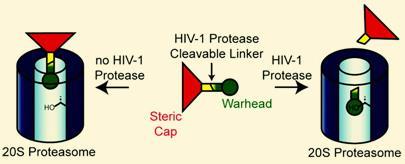'Trojan horse' molecule uses HIV to trigger the release of the very drug that could destroy the virus
US researchers have developed a ’Trojan horse’ molecule that uses HIV to trigger the release of a drug that destroys the virus.
Craig Crews and his group at Yale University, US, made the molecule, which consists of a proteasome inhibitor bound to a steric cap that stops the inhibitor entering the proteasome unless HIV is present in the cell. If HIV is present, one of the virus’ own enzymes will cleave off the bulky cap, allowing the drug to eventually kill the infected cell before the virus can replicate and spread.
Crews decided that because of the way the HIV virus integrates into patients’ bodies, to kill the virus would mean killing every HIV infected cell. This isn’t quite as dramatic as it sounds as in chronic HIV infection the virus is stored in a small reservoir of cells - Crews’ goal is to eliminate all of these cells.
In this proof of principle work the scientists took a drug they’d previously developed - a cytotoxic epoxyketone proteasome inhibitor currently in Phase III clinical trials for the treatment of cancer - and modified it to only be activated in HIV infected cells. They did this by adding a branched dendrimer of lysine molecules, linked to the proteasome inhibitor by a protein sequence that is cleaved by the enzyme HIV-1 protease.
The group showed that the dendrimer cap prevents the drug molecule reaching its target in the proteasome, but when HIV-1 protease is present the cap is cleaved and the drug can react with its target.

’What prompted all of this was the Grand Challenges Explorations grant from the Bill and Melinda Gates foundation.’ says Crews. ’They wanted us to think big about curing Aids.’
Ali Tavassoli of the University of Southampton, UK, thinks that Crews has had a ’really interesting idea’. Tavassoli, who investigates small molecules that inhibit diseases including HIV, would have liked to have seen evidence that the molecule can get into cells, but added that he would be ’very surprised if it was not cell permeable.’
Crews admits that the vast majority HIV is dormant in cells and might not express enough protease to activate the drug. ’It may be counter intuitive, but for this strategy to work we would actually have to reactivate the latent virus,’ he explains, something Tavassoli described as ’difficult,’ although this is an area of active research.
Laura Howes
References
et alJ. Am. Chem. Soc., 2010, DOI: /10.1021/ja109377p






No comments yet